 The AML Online Book Club will be discussing Noah Van Sciver’s graphic novel/biography Joseph Smith and the Mormons and his graphic novella/memoir One Dirty Tree on October 16 at 7pm, Mountain time. Noah will join us at 7:15 to answer questions about his work. Everyone is invited to attend.
The AML Online Book Club will be discussing Noah Van Sciver’s graphic novel/biography Joseph Smith and the Mormons and his graphic novella/memoir One Dirty Tree on October 16 at 7pm, Mountain time. Noah will join us at 7:15 to answer questions about his work. Everyone is invited to attend.
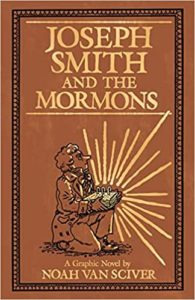 Joseph Smith and the Mormons was published in July to significant attention, including interviews in The New Yorker and the Salt Lake Tribune‘s Mormonland podcast.
Joseph Smith and the Mormons was published in July to significant attention, including interviews in The New Yorker and the Salt Lake Tribune‘s Mormonland podcast.Van Sciver’s cartooning in this book is superb. His aesthetic has always veered towards a reverence to the underground comix masters, and here he has an opportunity to flex his chops. The style is inviting and lush, while eschewing vanity, and his attention to period details, dress, and diction truly imbues each page with a certain authority. Though non-fiction, this is not a 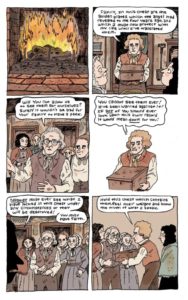 documentary, so there is more room to play and present ersatz authenticity and still walk away feeling as if one was dropped into Jacksonian America. Still, everything works remarkably well; there is never a dull panel or page. And ever the auteur, every page is colored by Van Sciver, giving readers a rare opportunity to see the full scope of author’s attention to every detail, no matter how minute. In brief, Noah Van Sciver’s Joseph Smith and the Mormons is a masterpiece of graphic nonfiction and could well be his magnum opus. It’s a singular work that weaves a remarkable tapestry of one man’s yearning for religious meaning, a country that fosters such spiritual innovation, and the darkness that these inclinations engender.
documentary, so there is more room to play and present ersatz authenticity and still walk away feeling as if one was dropped into Jacksonian America. Still, everything works remarkably well; there is never a dull panel or page. And ever the auteur, every page is colored by Van Sciver, giving readers a rare opportunity to see the full scope of author’s attention to every detail, no matter how minute. In brief, Noah Van Sciver’s Joseph Smith and the Mormons is a masterpiece of graphic nonfiction and could well be his magnum opus. It’s a singular work that weaves a remarkable tapestry of one man’s yearning for religious meaning, a country that fosters such spiritual innovation, and the darkness that these inclinations engender.
Publisher’s Weekly (Starred review)
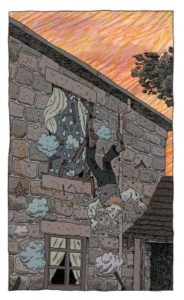 Van Sciver pulls off an ambitious feat: a nuanced graphic biography of Mormonism’s founder. . . . Van Sciver captures how the faithful hung on Smith’s charismatic oratory, and depicts spiritual innovations such as God as a deified human and baptism on the behalf of dead relatives. Van Sciver makes an intriguing artistic choice to present supernatural events, like Joseph’s visions of angels, in blue outline, and his oddly proportioned, oft-grimacing character drawings add levity and personality. Van Sciver was raised Mormon and expertly threads the needle here, allowing space for genuine belief while highlighting human moments of doubt, dissembling, and anger in the Latter-day Saint prophet. It’s an exemplar graphic narrative, reminiscent of Chester Brown’s Louis Riel, and will resonate with both believers and skeptics.
Van Sciver pulls off an ambitious feat: a nuanced graphic biography of Mormonism’s founder. . . . Van Sciver captures how the faithful hung on Smith’s charismatic oratory, and depicts spiritual innovations such as God as a deified human and baptism on the behalf of dead relatives. Van Sciver makes an intriguing artistic choice to present supernatural events, like Joseph’s visions of angels, in blue outline, and his oddly proportioned, oft-grimacing character drawings add levity and personality. Van Sciver was raised Mormon and expertly threads the needle here, allowing space for genuine belief while highlighting human moments of doubt, dissembling, and anger in the Latter-day Saint prophet. It’s an exemplar graphic narrative, reminiscent of Chester Brown’s Louis Riel, and will resonate with both believers and skeptics.
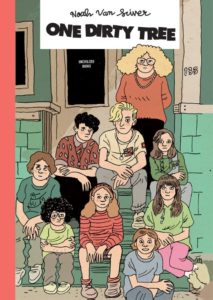 One Dirty Tree (2018), a graphic novella/memoir, was also widely praised, and received an AML Comics Award. The award citation read:
One Dirty Tree (2018), a graphic novella/memoir, was also widely praised, and received an AML Comics Award. The award citation read:
Noah Van Sciver’s One Dirty Tree is a powerfully haunting non-fiction novella. Its title refers to the dilapidated New Jersey home the author and his large family shared briefly during his childhood. While their stay was short, the house maintains metaphoric significance, revealing how Van Sciver’s childhood still impacts his adult life. The narrative moves between 1994, with Van Sciver exploring his family’s collapsing dynamics, and 2014, as he ends a doomed romantic relationship. The alignment of these plotlines promotes introspection through their echoing emotions. In 1994, he explores how Mormonism, mental illness, comics, neglect, and poverty shape his childhood, through moments that touch each other but never snap into perfect focus—clearly remembered bits revealing the overall shape of a childhood. While in 2014, Van Sciver considers the struggles of an emerging artist through vignettes of himself as the “American Cartoonist” as he battles with his 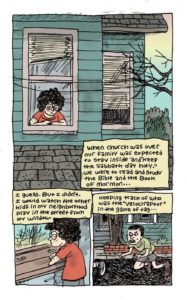 girlfriend and tries to navigate the perception his past creates in others’ understanding of him. He intertwines these explorations through central themes like unfulfilled dreams, loneliness, and childhood trauma. Drawn in his recognizable line, with incursions of his mother’s art or famous images from pop culture and fine art, Van Sciver’s visuals expand the narrative. Together, they resonate and provide a fresh look at the travails of growing up in chaos, poor and uncertain. The book ends, however, with Van Sciver standing beyond both 1994 and 2014, once again outside One Dirty Tree, and considering what meaning these justaposed storylines might hold for him—or for those of us listening in—today.
girlfriend and tries to navigate the perception his past creates in others’ understanding of him. He intertwines these explorations through central themes like unfulfilled dreams, loneliness, and childhood trauma. Drawn in his recognizable line, with incursions of his mother’s art or famous images from pop culture and fine art, Van Sciver’s visuals expand the narrative. Together, they resonate and provide a fresh look at the travails of growing up in chaos, poor and uncertain. The book ends, however, with Van Sciver standing beyond both 1994 and 2014, once again outside One Dirty Tree, and considering what meaning these justaposed storylines might hold for him—or for those of us listening in—today.
